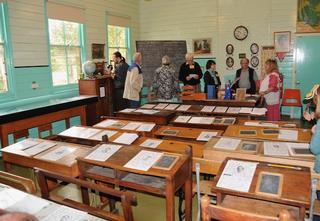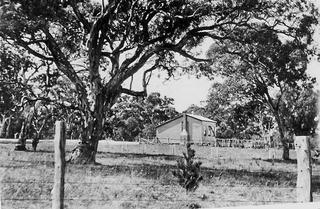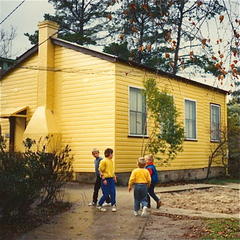Hall Heritage Centre
The Hall Heritage Centre is under the rubric of the Village of Hall and District Progress Association. After closure of the Hall Primary School in 2006, the Association took on responsibility for the protection and development of the Museum.
The Centre is under the direction of an Honorary Curator. The present Curator is Alastair Crombie who has been a resident in the village since 1976. Alastair has been a long standing committee member of the Progress Association and its President on several occasions. He was previously Executive Director of Adult Learning Australia and had a professional practice as a facilitator of change. The Honorary Curator is supported by three Deputies.
Volunteers
Anyone who is interested in supporting or being actively involved in the work of the Centre is encouraged to join the 'Friends of Hall Heritage Centre', which is formally constituted as a 'special interest group' within the Village of Hall and district Progress Association.Since taking over responsibility for the (then) Hall School Museum when the Hall Primary School was closed in 2006, the collection has expanded very significantly, and now includes a substantial volume of material pertaining to Hall-Ginninderra district history and heritage, including the lifetime collection of Lyall Gillespie. Hence a change of name to 'Hall Heritage Centre'.
Hall School Museum, now part of a much more extensive collection, remains a centre piece however
The School Museum Collection
The Hall School Museum collection at the time the school was closed in 2006 was the subject of an inventory commissioned by the ACT Government and carried out by the Australian National Museum of Education. This part of the collection contains approximately 2200 individual items. In addition to the century old school building, its furniture and school artefacts, the museum has three very distinctive and historically significant collections:
- A large collection of manuscript and documentary material dating back to the early decades of the twentieth century.
- The collection of audio-visual teaching aids and technological equipment contains a variety of 1930s and 1940s items of machinery including early model duplicators, projectors and record players.
- The school museum's very extensive collection of school textbooks and primary school library books, over 1000 books, dating from late nineteenth century through early twentieth century is most impressive, together with an historic collection of 62 sheet music items.
The school museum is particularly strong in its collection of manuscript material detailing the history and progress of the school from its establishment in 1911 to its closure in 2006. Included in the collection is not only a variety of early twentieth century classroom furniture and teaching aids, but also an exceptionally historic collection of early audio visual equipment, such as 1940s radio used to receive the ABC School Broadcast programs, all signifying the beginnings of the use of mechanical and early audio visual machines in class room teaching and early and mid- twentieth century learning environments and styles.
The documentary material includes class roll books, visitors books, teachers' programme and lesson registers, curriculum framework documents, admission register, punishment book, a variety of award certificates, P & C meeting minute books, teachers' lesson notes and correspondence files. There is also a particularly large collection of children's exercise workbooks, which provide an insight into the changing styles of writing and curriculum content across the decades.
In addition to the above listed items the museum has a school map display cabinet containing numerous maps of countries of the world, a collection of school uniforms from past decades, teaching kits, writing implements and desk items, a variety of plaques, shields and sporting trophies. Of particular historical significance is the wooden Honour Board containing the names of those former students who served in the Australian Military Forces in the First World War. A large collection of school and class photographs offers the researcher a perception of the school and its students dating from the years of World War I.
As is the case with all museums, only a portion of the collection is on display. The large majority of documentary items are stored in archive quality protectors in the storeroom or Annex cupboards. Limited space provides only limited display of documentary and manuscript material.
It is the comprehensiveness of this school museum, in terms of the large variety of its education artifacts, documents and school records which is its greatest strength, rather than the individual value of its items. It provides viewers and researchers with an insight into typical rural primary schooling in New South Wales during the first half of the twentieth century. As such it is a most valuable community asset, in its original geographical context, in addition to being an important part of the Canberra district's educational history.
This synopsis was contributed by Dr Geoffrey Burkhardt,Australian National Museum of Education
NOTE: The Inventory can be downloaded from our Document Register
The Hall School story
Hall Primary School was closed by the ACT Government at the end of the 2006 school year, five years short of it's centenary. The same Hall Progress Association that lobbied the NSW government to get the school established in 1911, worked hard to defend the school from closure, but to no avail. An earlier campaign to save the school from closure in 1959 was much more successful, resulting in new school buildings and a new Principal's residence.
Hall village was proclaimed in 1882, and the village plan including substantial space for 'public buildings'. At the turn of the century there were schools quite close by at both Ginninderra and at Bedellick; Ginninderra was the closer option for children from Hall. In 1903 the Bedellick school (Spring Range Road) was destroyed by fire, requiring those pupils to make the six mile journey to Ginninderra, some walking.
Petitioning for a new school in Hall began immediately, and persisted for the next seven years. In 1906 Charles Thompson, then teacher at Ginninderra "spoke in glowing terms of the fine stone building at Ginninderra, built at a cost of 1400 pounds, and of the well-established trees and shrubs" [Copping:1986:2]. He also pointed out that if Ginninderra were to be replaced, then some pupils would have to walk five miles or more to get to Hall.
In 1909, leading advocate for a Hall school James Kilby pointed out that twenty of the forty-five children at Ginninderra came from the Hall area. A parental petition argued that frequent flooding of Halls Creek endangered their children. More importantly Ginninderra school, which had operated since 1880, was surrounded by a few very large land holdings, while Hall was a public township with a growing population and 'two stores, one hotel, one accommodation house, a Post Office, one saddlers shop, one blacksmith and wheelwright.......'.
In January 1910 approval was given to the District Schools Inspector to call tenders, and approval of the new school was formally announced in the Public Instruction Gazette of 31 January 1910.
The building was 20 feet by 20 feet with two outside toilets on the eastern side.
By December the building was completed and furniture supplied. The furniture consisted of:
- Six long cedar desks
- Six forms
- Two blackboards and easels
- Two book presses
- One table, 3 feet by 2 feet
- One Austrian chair
An 800 gallon tank supplied drinking water. On the verandah was a wash basin stand and 30 hat and coat hooks. The building was painted in standard government colour with the name 'Hall Public School 1911' on the wall to the right of the chimney.
Within two years of the school opening Charles Thompson was requested by the NSW Department of Education to supply a 'history of the school'! His letter of reply says, in part:
"The school was opened on 30th January 1911 by C.W.Thompson with an enrolment of 37 pupils. The area of the school ground is 4 ac & care was taken in clearing the same to leave a number of native trees in the ground. This school was the first public building erected in Federal Territory after proclamation (emphasis added). The present enrolment is 30 and I am still in charge of the school. A photo of the building will be forwarded when procured.
I have the honour to be, Sir,
Your most obedient servant.
Chas. W Thompson"
Hall School - Timeline
1903: Bedellick school destroyed by fire
1910: Application for a school at Hall approved; tenders called
1911: Hall School opened. Teacher in charge – Charles W. Thompson
1912: First 'Empire Day picnic'
1915: Arbor Day; pines planted along Victoria Street side of the school
1919: 'Peace Tree' and thirty pines planted at the school by Red Cross Society
1933: Charles Thompson retired; farewell ceremony at Kinlyside Hall.
1933: Ray Harris appointed teacher in charge
1937: Ray Harris succeeded by Richard O'Sullivan
1957: Richard O'Sullivan succeeded by Keith Brew.
1957: Proposal to close Hall School. Resisted
1959: Weathershed enclosed as temporary classroom
1960: Hall upgraded to a Class 3 school, new residence and classrooms added
1960: Laurie Copping appointed Principal
1962: Water bore sunk; new toilet block built
1968: Further additional classrooms added
1971: Hall School Diamond Jubilee celebrations
1974: Federal Government takes over ACT education from NSW
1981: Laurie Copping retired
1981: Enrolments peak at 189
1986: 75th Anniversary. Governor-General opened the Hall School Museum
1997: Time capsule sealed. To be opened on the Centenary
2004: Governor-General dedicates the Museum to Laurie Copping
2006: Government announces closure of Hall Primary School
2011: Hall School Centenary
Some memories of Hall School
Extracts from 'Around the Butt Tree-Schoolday Memories in Hall, 1911-1957', compiled by Elizabeth Kilby.
Beryl Southwell
"There were six long desks with the pupils sitting on the forms without backs, four or five children to a desk. A fireplace was at one end of the room near the teacher's table. Two blackboards stood on easels, and there were two presses for books, one on either side of the fireplace. There was one door into the building and five windows. A clock hung on the wall over the fireplace. A small water tank outside provided the pupils with drinking water"
Heather Berg (1924-28)
"On 8 February 1933 Mr Thompson retired after 38 years at Hall and Ginninderra and 50 years teaching in the area. A public farewell in Kinlyside's Hall was attended by a large gathering of citizens and pupils to pay tribute to this devoted teacher who had given so many years of loyal services to the community An illuminated address and a wallet of notes was presented and many eulogized his qualities. A plaque was later unveiled in the school in honour of his faithful service".
"My family lived on a farm at Ginninderra. The suburb of Evatt is now built on part of it so it was quite a distance to get to and from school each day..........We would reach the main road (now the Barton Highway) in time to hear Charles Thompson come rattling along the gravel road in his sulky. He would stop and pick us up and drive us to school. Later on, we thought that as we were taught by him all day we did not want to ride in his sulky as well, so we walked in the paddocks until we heard him drive by and hen we would walk along the road meeting other school friends on the way.
Some days we would see George Schumack filling in pot-holes on the road with gravel, with his horse and dray standing by. Our parents warned us not to stop and talk to tamps along the way as there were plenty of them with swag and billy can walking to Canberra looking for work.
I was paid a penny for washing the dishes at home and often before school would stop at Southwell and Brown's store and buy a penny worth of dates – quite a handful. Then after paying homage to King and country we would be marched into school".)
Mrs Grace Brown (nee Kilby)
"I remember walking to school from 'Eneagh Hill' on the day I was sent to enroll as a pupil at the Hall Public School on 7 March 1915.
Each day we would assemble out in front of the school, in lines, boys and girls separate, at 9.00 am. The teacher would examine our hands and shoes or boots to see if they were clean. We would also salute the Australian flag and repeat, "I honour my God, serve my King, and salute my flag". We then marched into school singing 'Under the Greenwood tree'. All classes were housed in the one room. The lessons for the morning were written up on two blackboards, Junior and Senior............The school room was very cold in winter and hot in summer. A small fire smouldered in the fireplace and only the teacher benefited from that........Most children walked to school. Many walked several miles coming in from as far as Spring Range, Glenwood, The Glebe, and Wallaroo, and I remember that many of them came in bare feet."
M B S (Macks) Southwell
We lived on a property on the Spring Range , north of the village of Hall. It was about a three to four mile walk from home to school each day, depending on which route we took. Across the 'One Tree Hill' range the entire way was the most adventuresome.............The other route was along the Spring Range Road to the Yass Road, now the Barton Highway. We would meet other children along the way. There would be the Southwells from 'Wattle Park', the Moores from 'Gledeswood', the Morrises from 'Homebush' and others................As we made our way down the road in the early twenties we would be lucky to see two or three motor cars, as transport was mostly by horse-drawn vehicles – sulky, buggy, spring cart or wagon, but later in the 1920's perhaps a dozen cars might pass us".





